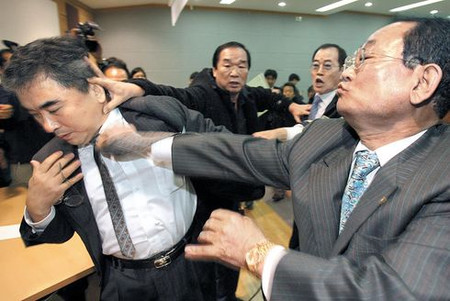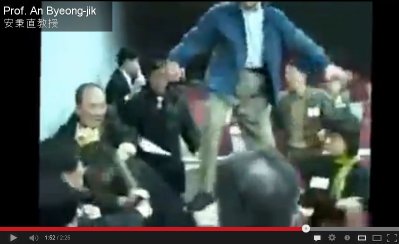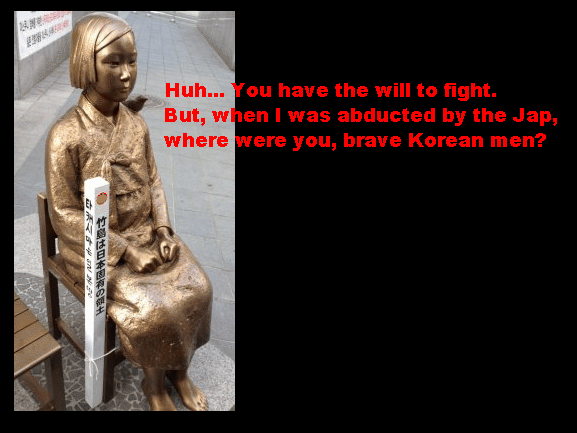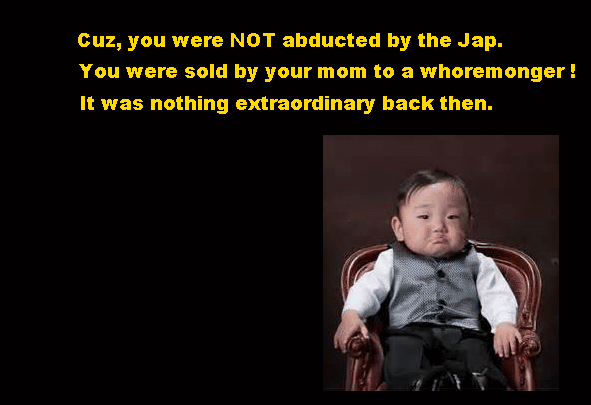| Prof. Lee Yong-hoon attacked by a mob | Prof. An Byon-jik attacked by a mob |
 |
 |
Anti-Japan hysteria is boundless in South Korea.
The author considers this is something to do with the so-called Ekisei Kakumei (Dynastic Change of Bloodline). Although South Korea looks like a modern democracy, its population actually still live in a pre-modern dynastic state. When an usurper grabs the power and becomes a new king/emperor, he needs to perish all blood relatives of the former king/emperor and, in order to justify the present regime, he and his subjects have to deny everything in the previous regime. They even re-writes history for justification of power-grab. We saw the same hate campaign in the Cultural Revolution in China. Whether this theory is true or false, the author believes that South Koreans' anti-Japan addiction reached the level of mental illness.
NOTE: Prof. An Byon-jik is the man who found out the diary of a Korean operator of a comfort station.
In a symposium in South Korea, Prof. Lee Yong-hoon (left) said "Comfort women were paid prostitutes" and Prof. An Byon-jik (right) said "Japan did some good things in the Annexation Era." Then the infuriated audience attacked them.
| Prof. Lee Yong-hoon attacked by a mob | Prof. An Byon-jik attacked by a mob |
 |
 |
| Click to watch the scene of barbarians attacking the two professors by Youtube video.¨¨ |
 |


In the male-oriented Confucius society of Korea, people had a long tradition of selling their first-born daughter for indentured prostitution in order to feed the rest of the family members.In return for the indentured prostitution, which continued for two to three years, the parents could earn a huge sum of money in the form of advance payment. Girls accepted their destiny out of their fealty piety. They were indoctrinated from the day they were born that self-sacrifice and contribution to the family was the paramount virtue of a girl. There was no way to change the situation for little girls anyway. (In the testimonies of former comfort women, you may notice that the gmomfs friendh living nearby often appears as a solicitor to go to a gbetter placeh where the girls could earn money or as a perpetrator of recruiters to leave the girl alone in a house.)
gKisaengh is the typical example of such indentured prostitution in Korea. Kisaeng is similar to Shiraboshi, the origin of Geisha in Japan. Their profession is to provide pleasure for rich males by such means as singing, dancing, playing musical instruments, and sex. The origin of Kisaeng can be traced back to 13 century, in which impoverished aristocrats contributed their daughters to rich aristocrats (in return for money) for possible marriage and family relationships, and wish for recovery of their previous aristocratic status.
Therefore, in the eyes of the author, the bronze statue of the girl means the symbol of indentured prostitution in Korea.
The life of indentured prostitution at wartime was not entirely filled with disgrace and suffers. Generally, the comfort girls were wealthier than ordinary girls. As the family of the soldier often sent expensive presents to the boy, the girl was able to get some of them. It was not uncommon that they fell in love with their "customers" and experienced marriage proposals.
Before returning to their home, the Japanese Army arranged that many of them could obtain vocational training such as hospital nurse (This is the case of Kim Bok-dong. She heard the defeat of Japan at a Japanese Army field hospital in Singapore) so that they could live by such vocation after the war and the life of a comfort girl would not interfere with their possible marriage at homeland. Therefore, comfort girls could say gI worked for the Army as a nurse at a field hospital.h More than half the comfort girls were Japanese nationals but no one came out expressing her complaints. The reader may understand why. They could conveniently conceal their life at the Army unless they reveal out of their own will.
The origin of a comfort station started when Japan sent troops to Siberia in 1918. Since venereal diseases of Russian girls crippled many soldiers, the Japanese Army allowed brothel operators to have their business within the camp premises and ordered army medics to provide regular medical checkups for soldiers and comfort girls. Condoms, medicine and other medical supplies were also provided.
The U.S. Army did the same when they occupied Japan. The author grew up and live in Yokohama Area, Kanagawa Prefecture, where the U.S. 8th Army (230,000 strong) landed in 1945 as the occupation force. The term gpan-pan girlsh were precisely equivalent to the comfort girls back then.
The U.S. Army marching at the center of Yokohama. The building behind the bridge still stands today. The local history reveals that the police prepared 300 pan-pan girls at first as the "Breakwater of Sex." Compared to 230,000 men, 300 was too few. But the the number of pan-pan girls soon increased to 70,000. Food was so scarce in defeated Japan and the demand-and-supply condition was soon balanced.
No one can look down those pan-pan girls. They did a great job of protecting ordinary life of the rest of girls since there were many rape cases reported. The book titled "The Black Spring" published in 1953 contains many horrible reports experienced by Japanese girls.
Victory brings a huge number of men with arms into a defeated country. Order and law enjoyed at peacetime are soon to become powerless. The U.S. Army was no exception.
The author believes that judging the past with todayfs value is sheer absurdity. Before the war, it was not uncommon that aunts or the motherfs friend gave the boy his first experience in sex. Prostitution was outlawed in 1958 in Japan. Before 1958, it was a completely legitimate business. Soldiers are young, green and at their peak of their reproductive activity as a male. Recreation and amusement is scarce in the Army life.
Today, in the 21st century, the Korean government estimates the number of prostitutes working abroad is 100,000. The prostitution has not been entirely outlawed in Korea (although showing naked body from within the glass-doors was prohibited in 2004). You can see modern-day Korean comfort girls everywhere in the world.
The author cannot see how such a country can blame Japan claiming that girls were dragged out of their village at gunpoint. It is simply a lie. Histry reveals 70% of policemen were Korean during the annexation era. Koreans are blame-shifting what they were doing to Japan.
The Korean government put the comfort women issue on the diplomatic table over and over again, although any and all reparation for civilians was expressly included with the wording as "completely solved as final" in the peace treaty of 1965. Obviously, the Korean government is using the comfort women issue as a sly, despicable government manipulation.
|
|
Return to Home |